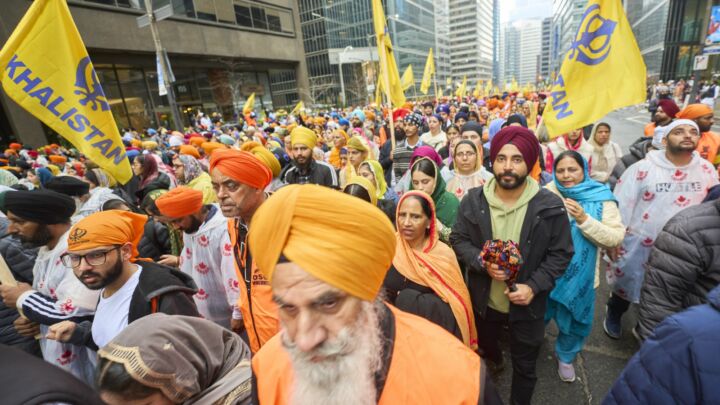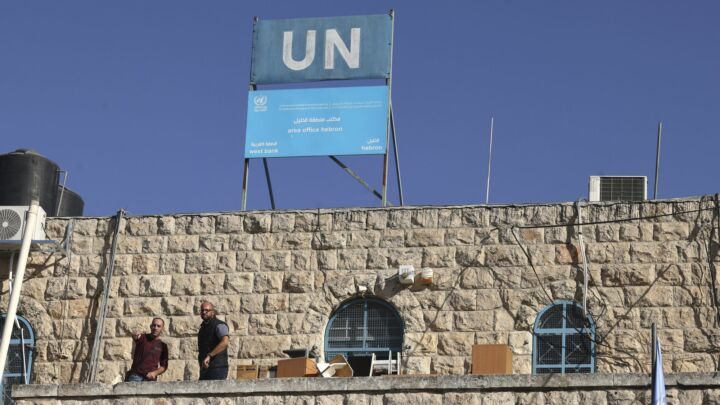How the burqa became a symbol of freedom
France’s attempts to defend the idea of the Republic through an illiberal ban on Islamic headscarves has backfired.

Want to read spiked ad-free? Become a spiked supporter.
In a speech defending his ban on full-face veils, French president Nicolas Sarkozy lamented that such face coverings keep women ‘isolated from social life’ and ‘deprived of personality’. Since the ban came into force on 11 April, dozens of these supposedly isolated and deprived women have taken to the streets in rather assertive acts of protest.
On 11 April itself, several niqab-clad women staged protests outside Notre Dame and other key Parisian monuments (one appeared to be resisting arrest). A couple of weeks later, a young veiled woman stood in front of the National Assembly, in a protest that was also a provocation for a fine (which she was annoyed she didn’t get).
According to the minister of the interior, ‘27 or 28’ women have been punished for wearing the face-veil so far. These are not all Saudi Arabian visitors or deferential Muslim wives – a woman fined in Nice a few days ago was both a convert and a single mother.
These fines are sparking spontaneous scuffles and support for the women concerned. A teacher from a private Muslim school in Toulouse was stopped and fined €150 for wearing her niqab; when a technician started filming the scene he was promptly arrested, and a spontaneous demo formed outside the police station demanding his release.
Now a new battle line has formed in schools, with headscarf-wearing mothers protesting against their exclusion from accompanying their children on school trips. These mothers wear a simple headscarf rather than a niqab, yet an increasing number of schools judge that their headwear makes them unfit ‘representatives’. On 2 May, reported Le Monde, a group of mothers rallied outside a school in Montreuil, ‘not defending a religious cause but fighting against injustice’.
It is striking that these protesters put their case in terms of Republican values, such as liberty. The main Muslim organisation opposing the burqa ban is called ‘Hands Off My Constitution’, and the mothers defending their right to wear veils on school trips call themselves ‘Mothers All Equal’. In these face-offs between veiled women and police, it seems, the line between the state and public freedoms is being contested.
To English eyes, these are strange scenes indeed. There is no UK government legislation on the veil, and while teachers can wear the headscarf, mothers (and many employees) can wear the niqab without raising many eyebrows. It is the peculiar severity of the French state’s attack on the veil – in the country with the largest Muslim population in Europe – that has turned Islamic headwear into such a key libertarian issue.
The French war on headscarves started in 2004, with a ban on pupils wearing headscarves to school. As the French sociologist Olivier Roy observes in his book Secularism Confronts Islam, there was a particular focus on the Islamic headscarf, which was seen as causing problems that the Sikh turban and Jewish skullcap did not. This was less to do with the inherent qualities of the headscarf, than the way it became an emblem for the French state, as a kind of anti-Republican symbol. Politicians of all parties lined up to support the ban in 2003, waxing lyrical about how the law would establish the ‘permanence of our values’ and be ‘constitutive of our collective history’, a ‘principle factor of the moral or spiritual unity of our nation’, a ‘founding principle of our republic’ and so on and so on (1). Suppressing the headscarf became the supreme Republican act, the primary way in which law-makers could make a grand statement of principle.
This new law wasn’t driven through as a reaction to events occurring at the time. As Christian Joppke outlines in his book, Veil: Mirror of Identity, ‘the number of concrete conflicts surrounding the veil was at a 10-year low in the summer of 2003’, with only ‘1,256 counted cases of veiled students throughout France’. The drive for a ban came from within the political elite and its need for a ‘mirror’ against which to define itself.
The leftist intellectual Régis Debray was on the commission that recommended a ban, and it is telling that in his 80-page tract on why the veil should be banned he barely mentioned the item in question. He mainly lamented the growth of American television and consumerism, the decline of Marianne and the rise of TV talent show Star Academy: Republicanism has lost its soul, he said, becoming an ‘opinion and not a conviction, an absence and silence’.
The need for an anti-Republican symbol comes from the distinctive nature of the French state, which has an explicit ideology in a way that the British state does not. While British institutions tended to evolve in an informal manner, retaining all kinds of anachronistic symbols and systems (‘it may seem odd but it works’), French institutions were justified very explicitly, heralded in speeches and spelt out in codes. The ‘Republic’ stood as a forger and unifier of society, without which people would apparently split asunder.
For two centuries after 1789, the anti-Republican enemy was the Catholic Church, and this formed the primary schism that lay at the heart of political life. Now, says Roy, the old conflict of Republicanism versus the Church has been replaced by Republicanism v Islam, and the veil in particular.
By asserting itself over the veil, the state asserts its values and its domain. For all politicians’ talk of women’s rights, it is actually the fact that the veil is perceived as ‘aggressive’ that motivates the bans. The veil is seen as both a barrier put up against public authority and an explicit challenge to secular values. Debray describes veil wearing as a ‘militant act’, while former president Jacques Chirac judged that there is ‘something aggressive’ about the veil, and the secular state could not tolerate such ‘ostentatious signs of religious proselytism’.
It seems that a barren republicanism experiences the veil as an ‘ostentatious’ threat to its own existence. To fail to legislate would be, according to Debray, a ‘signal of weakness or withdrawal’, while a ban would provide a ‘proof of force’ of the highest order. As Roy observed, banning the veil is ‘more to do with territorial re-conquering than with the defence of neutrality’.
Since 2004, French headscarf legislation has become increasingly interventionist, squeezing the domain of individual liberty almost out of existence. A series of 1990s legal decisions in headscarf cases had defended pupils’ freedom of expression: the courts distinguished between representatives of the state (teachers) and citizens (pupils), and judged that while teachers should be neutral and could not wear religious dress, pupils as citizens have ‘freedom of conscience’ and therefore could. (Interestingly, Nicolas Sarkozy was one of the few politicians who opposed the 2004 law, arguing with the judges that ‘it isn’t the child who has to be laic [non-religious] but the school’.)
Now, control over pupils’ dress is further extended to veiled parents – because of their mere presence on a school bus, they are dragooned into the ranks of official representatives and therefore equally subjected to dress codes.
Sarkozy’s 2010 law banning the veil in public places was the coup de grace for the domain of free expression. The 2004 law was very clear that such legislation was only for the school, not for public places such as squares and streets. While schools are places for the transmission of Republican values, argued Debray, streets are public places for free expression and debate. There would be no question of regulating dress ‘on the Metro, in cybercafés, in supermarkets…’. Yet this is precisely what happened. Legislation has ‘conquered’ more and more territory, and the space for free expression in dress is in effect reduced to the private sphere of the home.
It is the nature of the clampdown on the burqa that makes it a potentially universal freedom issue in France. In the UK – where there is no such legislation – the ‘right’ to wear the headscarf has mainly been defended by petulant schoolgirls rebelling against their school uniform code (most notably, a girl who wanted to wear a slightly different form of Islamic dress to that allowed by her school). Yet in France, the headscarf affair has become a libertarian frontline with resonance for people of all religions.
The ‘Mothers All Equal’ group says that they speak as ‘women and men, veiled and unveiled, in solidarity to defend a basic freedom’ – and a basic principle, that ‘the democratic state should not impose on citizens their mode of dress’. They were joined on their most recent demo by a number of non-Muslims, including some local young feminists who saw it as a basic equality issue.
The ban has also sparked some classic French situationist protest, including ‘Princess Hijab’, a graffiti artist who paints veils on fashion ads in the Parisian metro, and the ‘Niqabitches’, two young women who donned niqab and hotpants for a tour of the main departments of government (they posed, waving, outside each ministry that had been responsible for the ban). The two young women said that they themselves didn’t understand why anyone would want to ‘cover the face like Dark Vader’, but they defended the idea of the Republic as ‘a space of free expression within which everyone can choose their own way of dressing and practicing their religion’. In their view, the ban represents ‘an insane need by the Republic to assert control over the bodies of its citizens’, which goes beyond all ‘legitimate’ power.
How the burqa wars will end is as yet uncertain. What is certain is that, far from resolving the crisis of Republicanism, lawmakers’ headscarf bans are instead having a highly perverse effect: turning an archaic, restrictive form of dress into a liberty cap for the twenty-first century.
Josie Appleton is convenor of the Manifesto Club, a civil liberties campaign group, and is speaking on burqa bans on 31 May in Berlin, at an event organised by Novo Magazine. Email her {encode=”[email protected]” title=”here”}.
Celebrate 25 years of spiked!
A media ecosystem dominated by a handful of billionaire owners, bad actors spreading disinformation online and the rich and powerful trying to stop us publishing stories. But we have you on our side. help to fund our journalism and those who choose All-access digital enjoy exclusive extras:
- Unlimited articles in our app and ad-free reading on all devices
- Exclusive newsletter and far fewer asks for support
- Full access to the Guardian Feast app
If you can, please support us on a monthly basis and make a big impact in support of open, independent journalism. Thank you.






Comments
Want to join the conversation?
Only spiked supporters and patrons, who donate regularly to us, can comment on our articles.